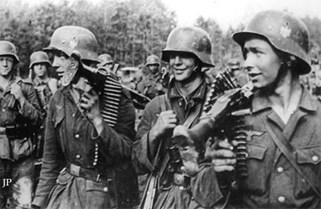The Nazi German Army 1935-1945 (Heer)

The Nazi German Army, Heer, was formed in May of 1935. It was formed after the passing of the “Law for the Reconstruction of the National Defense Forces”. This law brought back into existence a free-standing German army, navy and air force, something that had been essentially banned after the end of World War I.
With the end of World War I and the signing of the Treaty of Versailles in 1919, the Weimar Republic – the successor to Imperial Germany – was allowed only a small defensive military force known as the Reichswehr. The Reichswehr’s size and composition were strictly controlled by the Allies in the hope that by restricting its constitution they could prevent future German military aggression. The Reichswehr consisted of 100,000 men divided between a small standing army, the Reichsheer, and a small defensive navy, the Reichsmarine.
In 1933 the National Socialist German Workers Party (NSDAP) came to power and the infamous Third Reich was born. Two years later in 1935 the Treaty of Versailles was renounced and the Reichswehr became the Wehrmacht. The newly formed Wehrmacht would still consist of an army and a navy – the renamed Heer and Kriegsmarine, but a new air force was born as well – the Luftwaffe.
The Heer initially consisted of 21 Divisional sized units and 3 Army Groups to control them, as well as numerous smaller formations. Between 1935 and 1945 this force grew to consist of hundreds of Divisions, dozens of Army Groups and thousands of smaller supporting units. Between 1939 and 1945 close to 13 million served in the Heer. Over 1.6 million were killed and over 4.1 million were wounded. Of the 7361 men awarded the initial grade of the highest German combat honor of WWII, the Knights Cross, 4777 were from the Heer making up 65% of the total awarded.
Between 1939 and 1945 the Heer bore the majority of six years worth of fierce combat, some of which was so fierce – as on the Eastern Front – humankind will likely never again see such fighting. Although not immune to the overtones of politics and the occasional brush with questionable actions, the vast majority of German Heer units served with great distinction across many thousands of miles of battlefields.
The Heer was defeated with the German capitulation on May 8th, 1945, although some units continued to fight for a few days longer in fits of sporadic resistance, mainly against the Soviets in the East. The Allied Control Council passed a law formally dissolving the Wehrmacht on the 20th of August 1946, the official “death” date of the German Heer.
The basis for Feldgrau lays within our unit histories. In this section you will find all units documented to one degree or another. The many gaps in these listings will be filled during the coming months and years as additional research aids completing this monumental reference tool.
Heer unit histories
- 1935-1945, Heer ground units
Specific unit history sections
- Heeresgruppen – Army Groups
- Armeeoberkommandos – Army Commands
- Infanterie-Divisionen – Infantry Divisions
- Leichte-Infanterie-Divisionen – Light Infantry Divisions
- Infanterie-Einheiten – Infantry Units
- Volksgrenadier-Divisionen – Volksgrenadier Divisions
- Gebirgs-Divisionen – Gebirgs Divisions
- Grenadier-Divisionen – Grenadier Divisions
- Panzer-Divisionen – Panzer Divisions
- Divisionsgruppen – Division Groups
- Sturmgeschütz Units
- Sturm-Panzer-Abteilungen
Other sources for unit history information
Before embarking on any study of German unit histories it’s helpful to have access to research material regarding ranks, formations, terms and other related concepts.
- Glossary of German Military Terms
- WW2 Germany Statistics, Numbers, and Losses
- WW2 German Identification Documents and Tags
- Weapons and equipment
If you have a question about a concept or something specific, you can post a message in our German Armed Forces Forum.
RESEARCH THEMES
OUR RESEARCH THEMES
Select ThemeReichswehrThe German Imperial Army 1918 – 1935
anchourReichsmarineThe German Navy 1919-1935
anchourHeerThe Nazi German Army 1935-1945
anchourLuftwaffeThe Nazi German Air Force 1935-1945
anchourKriegsmarineThe Nazi German Navy 1935-1945
anchourWaffen-SSThe Nazi German Armed Waffen-SS 1933-1945
anchourWehrmachtsgefolgeAuxiliary Organizations
anchourFreiwilligeForeign Volunteers
anchourAlliierteAxis Powers
anchourKollaborationAxis Collaboration
anchour
